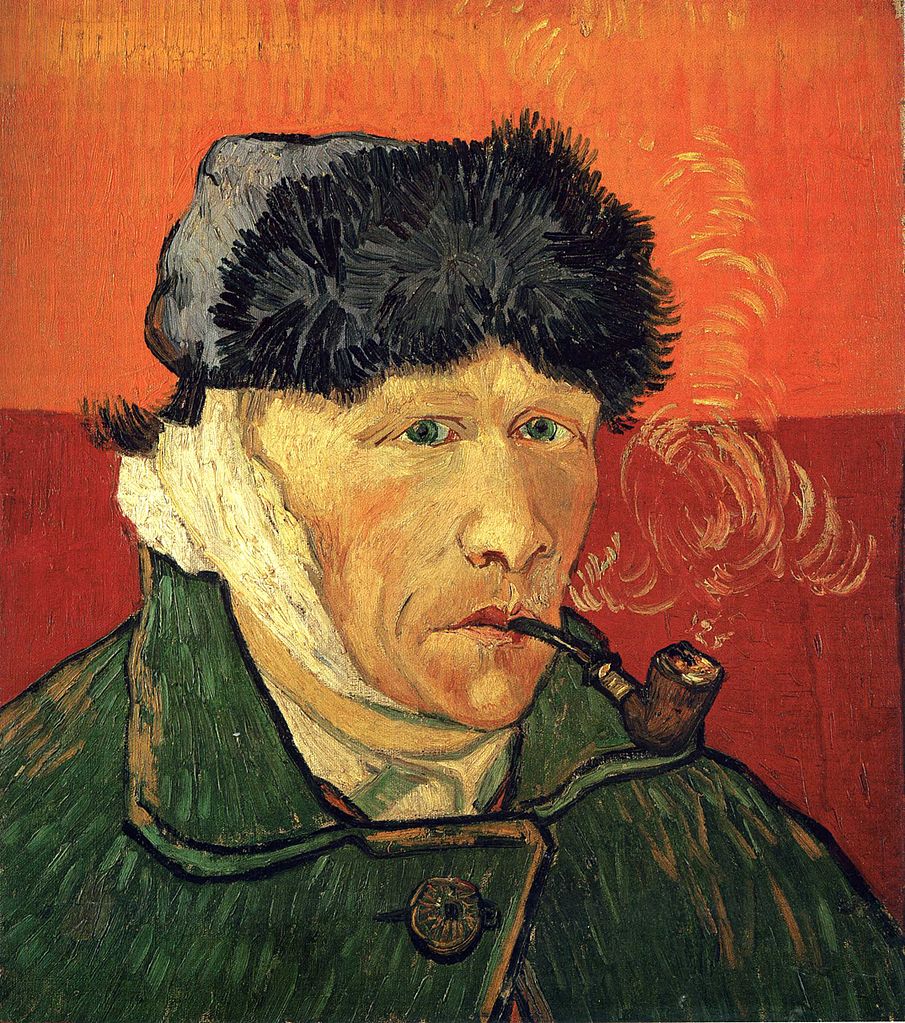Vincent Van Gogh was an admired artist, who was also a troubled and “tortured genius.” His artwork, Starry Night, Bedroom in Arles, and many others have earned him fame and recognition as one of the greatest artists of his time. But what many remember most about this artist is the story of his severed ear. Although his art is exemplary, his struggle with mental health and self-harm is admirable. His struggle was overlooked due to his incredible talent. He was successful as an art dealer, but as an artist, he had to prove himself with the headquarters of international art dealers, Gopil & Cie. During his lifetime, Van Gogh was the poster boy for the image of starving artist. His artwork was not recognized until much later in his career, which could have been a leading cause of his major depression and anxiety.1
Van Gogh, born in the Netherlands, decided to start his career in Paris in the 1880s, where many of the age’s great artists also resided. He believed he could get recognition for his pieces through his younger brother, Theo, who made his living as an art dealer. His brother introduced him to many artists, including Georges Seaurat, Camille Pisatto, and Paul Gauguin. Upon meeting these successful artists, Van Gogh was greatly inspired by their work and began creating his own artistic style, beginning in 1883. Later the same year, Van Gogh rented a small house in Arles, in the south of France. Paul Gauguin and Van Gogh became close friends and later roommates. They consistently bounced ideas off of each other and created a strong friendship.2

Like many friendships, theirs was rocky, and they found themselves drifting apart. Gauguin had moved on to a different artistic style and was exploring other ideas. Van Gogh at the time, had been reciprocating signs of depression and mental health issues, but at the time, these symptoms were considered normal. When Gauguin decided to explore other art spectrums, it involved moving out of the house he and Van Gogh shared. He broke the news to his roommate about his intentions, and this evidently this made Van Gogh go over the edge. He did not take the news lightly and both men began verbally arguing. Van Gogh had disappeared for a few hours and when he returned to confront Gauguin, he had a razor blade in hand threatening to hurt Gauguin.3
During the confrontation, however, Van Gogh was hesitant to hurt his friend and decided to turn the blade on himself and completely cut off his ear. Gauguin left him bleeding and alone. Van Gogh bandaged his head and began drowning himself in alcohol. During this episode, he walked out of his home and into the streets where he found a prostitute. The ear that he had severed off of himself had been neatly wrapped in a cloth; since Van Gogh was still heavily intoxicated, he decided to present this token to the prostitute. Patiently, she ran off and alerted the police about her encounter and they immediately rushed to his home.4
Shortly before Christmas Eve, Van Gogh was found by police in his bed, partially conscious and with major blood loss. Authorities rushed him to the hospital where he surprisingly recovered. Meanwhile, Gauguin was brought into questioning, but gave no testimony on the incident. It was believed that Van Gogh had suffered a severe mental breakdown long before he had severed his ear, but that this created a ripple effect that led to lunacy. The real reason behind the infamous Van Gogh ear-cutting may never be known; Gauguin had promised Van Gogh a pact of silence on the situation in letters that they supposedly exchanged. 5

After the incident, Van Gogh was admitted into a psychiatric facility in hopes of recovering mentally and physically. The dramatic change was not helpful for such a troubled artist, and in July of 1890, Vincent Van Gogh ended his life with a revolver. Before his suicide, however, he created a very iconic painting, Self Portrait with Bandaged Ear 1889. Van Gogh intended to persuade his doctors that he was perfectly able to continue working and creating art by creating this self portrait. He presented his piece, leaving a trail of wonder for his supporters as to why he included certain details in this particular piece, mainly because he continued to paint himself in the same yellow house he and Gauguin shared. Doctors overlooked these details and allowed Van Gogh to leave the facility.6
The epidemy of many artists like Van Gogh is often associated with mental instability, drug use, and alcohol abuse. Van Gogh had an array of medical issues that were tied back to his coping mechanisms (alcohol abuse), and as a result, many did not understand the struggles he faced and degraded him as a person while idolizing his artistic talent. As said before, the real reason behind his mutilated ear will be unclear, but his work and talent will continue to inspire and educate.
- Adam Gopnik, “Van Gogh’s Ear,” The New Yorker, Literature Resource Center (January 4, 2010): 48. ↵
- “Who Really Cut Off Van Gogh’s Ear?” Weekend All Things Considered, Literature Resource Center, (May 2010). ↵
- “Who Really Cut Off Van Gogh’s Ear?” Weekend All Things Considered, Literature Resource Center, (May 2010). ↵
- Belinda Thomson, “Comparing lives: issues of balance in biographical writing,” Literature Resource Center, French Politics, Culture and Society 24, no. 2 (2006): 60. ↵
- Tim Suermondt, “All the Answers.” Literature Resource Ceter, Prairie Schooner 85, no.3 (2011): 47. ↵
- Tim Suermondt, “All the Answers,” Literature Resource Center, Prairie Schooner 85, no. 3 (2011): 47. ↵



170 comments
Sara Alvirde
This was a rumor I have heard about the artist Van Gogh but had never done research on his hearing loss! I never knew that he had dealt with so much stress especially because of how light-headed and vibrant the colors are in his drawings. It so sad to hear his sad life while creating such beautiful worlds in his paintings and people, he is such a great artisit.
Hailey Lechuga
This article was fascinating, like the majority of people I’ve known about Van Gogh, his severed ear, and somewhat about his struggle with mental health but not to this extent. The human psyche is marvelous in that a brain as powerfully artistic as his could be inflicting so much pain at the same time. It’s really saddening that the awareness and knowledge of mental health that we have now took so long to acquire.
Maria Ferrer
I have known Van Gogh’s famous paintings for a very long time; however I never knew about his struggles with his mental health and alcohol. Additionally, I didn’t know the story behind that severed ear until after reading this article. It amazes me how people can create masterpieces while going through something like Van Gogh did, it is clear that there is a whole new story behind each painting. This article was very interesting to read and definitely makes me want to learn more about Van Gogh’s life.
Adam Alviar
This article was intriguing to say the least. It’s impossible for me to wrap around my head, how this man was physically capable of cutting off his own ear, as I could never do that even in my craziest dreams. It’s interesting to see the real colors of Van Gogh of who he really is, and not only seeing his artwork, but also only seeing his artful portfolio we are now exposed to the truth. It’s odd to look at his artwork and then look at this article as his artwork seems to be an extreme opposite representation of his mental health and well being.
Shanita Frazier
I’ve always admired Vincent Van Gogh’s art work but I was unaware of his mental health illness. It saddens me that his mental impairment was overlooked due to talent. I still think that happens today with celebrities, how some people assume the celebrities are happy because they are famous but in reality they may be suffering from mental illness like Britney Spears during her meltdown. This article is great and also alarming because of how attached they were as friends. And to think depression was considered normal at that time is also very sad.
Victor Rodriguez
It is amazing how the beauty of art can help a person with a mental illness get through their challenges. I have studied Van Gogh in a variety of art courses before and I am always incredibly impressed his immense determination he had to create art regardless of the mental difficulties he was experiencing. I believe his art work is simply very artistic but at the same time very meaningful. Van Gogh ability to expand the imagination of his audience is something I will always personally admire and thank him for.
Nadia Manitzas
It was very entering that “the epidemic of many artists like Van Gogh is often associated with mental instability, drug use, and alcohol abuse.” With Van Gogh it showed that in his paintings where he was perceived to be happy and healthy was in France, due to the bright colors. This is how he dealt with his mental illnesses, he had so many issues that many people weren’t aware of which os heartbreaking because he produced such amazing art. Overall, a really interesting article with great detail.
Janaya Felder
This article was so interesting. I had no idea that Van Gogh had lost an ear, let alone cut it off himself. I knew he had some issues with his mental health, but I had no idea it was as bad as it was. This article captured how difficult it was for him as he battled with his mental health. I’m sure people thought of him as strange, especially the prostitute he gave his ear to as a “gift”, but now he’s known as one of the greatest artists of his time.
Justine Ruiz
This is a very interesting article. I didn’t know behind the unique paintings was a man struggling with mental illness. I believe him painting may had helped a bit with his issues yet may have been taken to the extreme. I cannot believe he cut his own ear off and didn’t go to the hospital right away since he was heavily intoxicated. If the prostitute had never called the police, would he have bled to death? Van Gogh was a prime example of why psychiatric facilities should play attention to the details of every patient. I never knew Van Gogh committed suicide until reading this article.
Nicolas Llosa
This article was really insightful. It’s crazy how such a well-known artist like Van Gogh had a whole other side of him that isn’t portrayed in his artwork. He moved from the Netherlands to France for inspiration and his art changed drastically. The artworks he made while living in France are mostly, happy, colorful, and bright which you could say portray the opposite of how he felt since he dealt with many mental illnesses. This article helped me understand how complex and complicated Van Gogh’s life was, and how even though he is now a very well-known artist, during his life, he had to deal with many issues that a lot of people didn’t know about or chose to ignore. I feel like he was such a complex person that nobody got him and his personality, he wasn’t admired or liked as a person, but now his artwork is exhibited in the most important museums of the world.